This post may contain affiliate links at no additional cost to you. As an Amazon Associate I earn from qualifying purchases. Click to view our full disclosure.
What's inside
Hello, and welcome to this guide on how to eat less.
Eating fewer calories than the body needs is called a caloric deficit. A caloric deficit is a must if you want to lose weight.
Of course, it’s not as simple as it sounds. In my years of experience as a registered dietitian, I’ve seen that while meal plans can help, many people only follow them for a couple of weeks.
The truth is, you don’t have to go hungry or follow a very strict diet to get that caloric deficit. Making changes in certain habits can lead to sustainable, long-term weight loss results.
This article is full of tips and tricks I’ve offered my clients over the years to help them achieve weight loss. They’ve all been tried and tested for real results.
Let’s get started!
Why do people try to eat less?
Related: Find Your Perfect Balance With Our 1400 Calorie Meal Plan
The main reason people try to eat less is to lose weight.
You need to be in a caloric deficit to lose weight. You can accomplish this by exercising, meaning you burn more calories than you eat, or you can decrease your caloric intake.
The best way may be to do a combination of both. In fact, research shows that people who modify their diet and exercise can have better weight loss results.
The Benefits of Eating Less
Related: What Is The 80/20 Rule Diet?
Besides weight loss, there are several other benefits of eating less.
One of the benefits of eating less is that it might help slow aging and reduce the risk of chronic illnesses like heart disease and diabetes.
Also, eating less can help improve digestion. It can help reduce symptoms like bloating, gas, and stomach cramps.
Finally, some find that eating less can help improve sleep, mood, and sex drive.
The Drawbacks of Eating Less
While you might want to eat less, you still have to make sure you’re eating enough to avoid these disadvantages.
The first drawback relies on the number of calories you are reducing. A very low-calorie diet (below 1,200 calories or the basal metabolic rate) can slow down the metabolism and affect hormonal processes.
It can also put you at risk for a nutrient deficiency and increase the risk of fertility problems.
Finally, if you start eating less without making any lifestyle changes, you are more likely to gain the weight back (and even more).
To avoid these complications, consult with a registered dietitian to guide you into the necessary nutrients and calories for your weight, height, age, and activity levels.
How To Eat Less Food and Feel Full
Related: 32 Foods That Burn Belly Fat Fast

The secret to training yourself to eat less is to find those foods which are highly satiating but with a low caloric impact.
There are two main food groups that check both marks: non-starchy vegetables and lean protein.
Non-starchy vegetables are high in fiber which takes longer to digest, making you feel fuller. They’re also very low in carbs and calories, making them an excellent replacement for higher-calorie foods.
However, more on food replacements later in the article.
Protein, like non-starchy vegetables, also takes longer to digest in the stomach, meaning it increases your fullness levels.
The combination of non-starchy vegetables and protein allows you to eat less without starving during the day.
Finally, how you eat also matters.
For example, the speed at which you eat, how many times you chew, and what you are focusing on during the meal.
So, let’s get to the good part of the article. Here are all of the tricks I’ve taught my clients to help them eat less.
10 Best Simple Tricks To Eat Less
Here are the 10 best simple tips to eat less.
These are ways to help you achieve a caloric deficit without suffering or thinking about food all day long because you’re starving.
1. Practice Mindful Eating
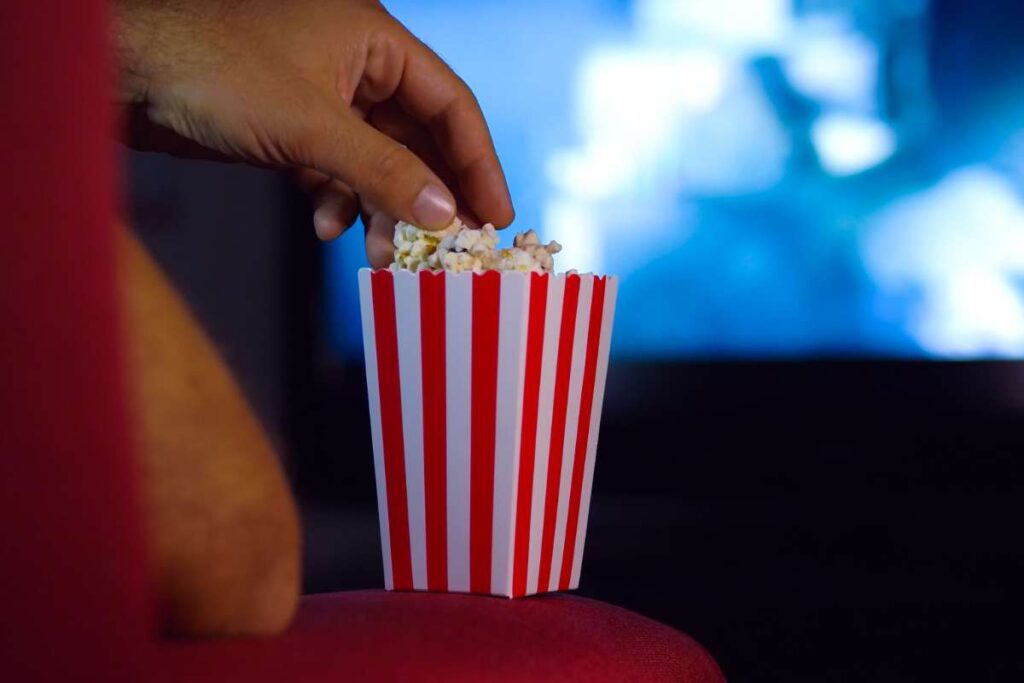
The first thing to help you eat less is to eat mindfully.
Mindful eating means paying attention to the food in front of you. It typically takes 20-30 minutes for the stomach to signal that it is already full.
If you’re watching TV or looking at your phone while eating, it can make you eat more than you would have if you had just paid attention to your food. You’re messing with the signal.
Therefore, the first thing to do when practicing mindful eating is to avoid distractions.
The next time you are eating, turn off the TV, put the phone away, and focus on the plate in front of you.
Use all five senses to describe your food. How it looks, feels, smells, tastes, and sounds.
This exercise can help you ground yourself in the experience and allow you to pay closer attention to food.
Another exercise I like when practicing mindful eating is slowing down on eating.
Most people tend to eat fast. This jeopardizes the gut-brain signal and can make you eat more.
In fact, a study showed that children who ate fast had three times more chance of being overweight.
Next time, pay close attention to your eating speed. Is it fast? Is it slow?
Put a timer and check how much time it takes you to eat. It should take you around 20-30 minutes to have a meal.
If you’re eating in less than 10-15 minutes, here are some things you can do to slow down your eating.
- Eat with your non-dominant hand.
- Place the fork and knife down between each bite.
- Count the number of chews (25-30 for each bite).
- Place a timer and try to last for the set time.
2. Only Eat at the Table

One thing I’ve noticed people often do is mindlessly snack.
Whether you’re a mom nibbling on the leftovers from your child’s plate or nibbling on anything you find as you clean the kitchen, you start increasing the calories without noticing it.
For that reason, one of the things I recommend for eating less is that anything you eat must be placed on a plate and at the table.
Even if you’re having a snack, it should be portioned on a plate, and only have it while you’re sitting down.
This exercise goes hand-in-hand with the point mentioned above, which is mindful eating.
When you sit down and stare at the foods you have in front of you, you are less likely to overeat.
Also, don’t eat out of the bag. Make sure you portion everything out. Even better if you can portion everything out as soon as you get home from the store.
3. Use Smaller Plates

The size of a plate can have an impact on how many calories you eat. Research shows that the larger the plate, the more food you put on it.
In another study, Chinese restaurants that had larger plates served 52% more and customers ate 45% more.
So, next time you’re trying to cut back on your calories, switch the larger plate for a smaller one.
As a suggestion, make sure half the plate is at least non-starchy vegetables.
4. Avoid Liquid Calories

While this is something you are going to constantly hear, it is surprising how many people still drink their calories.
Soft drinks, alcoholic beverages, and fruit juices are all options high in calories with a low satiating effect.
For example, a regular soft drink has around 240 calories with 65 g of added sugars.
This would be the same as adding 16 teaspoons of sugar to your morning coffee. An insane amount!
The problem with drinking your calories is that you don’t realize you’ve consumed so much. It’s very easy to increase your caloric intake without you noticing.
So, next time, switch to a diet version instead of going for the regular soda. Also, instead of fruit juice, opt for water or unsweetened iced tea.
In case you are going to drink, avoid cocktails since they are high in sugar and calories. Opt for drinks that you can add non-caloric beverages. For example, whiskey on ice or rum with diet coke.
With that said, make sure you don’t have more than a couple of drinks per week since alcohol can affect the weight loss process.
5. Prepare Your Meals Carefully

Planning ahead and making meals at home can be a great way to save calories and help you eat less.
While we all love eating out, we cannot control how much oil they use for cooking and the ingredients used.
If you’re eating less to lose weight, the best thing you can do is start making homemade meals. When you cook at home, you have all of the control.
To be successful, plan the meal ahead of time. Write down what you are going to have each day and describe it in detail.
Also, write down the times you are going to eat out (make sure they are not very frequent).
Finally, to avoid adding any unnecessary calories, measure the amount of oil you are using (never eye-ball it), or if not, switch for a spray or use a brush with some oil to lightly coat the pan.
6. Get Enough Sleep and Manage Stress
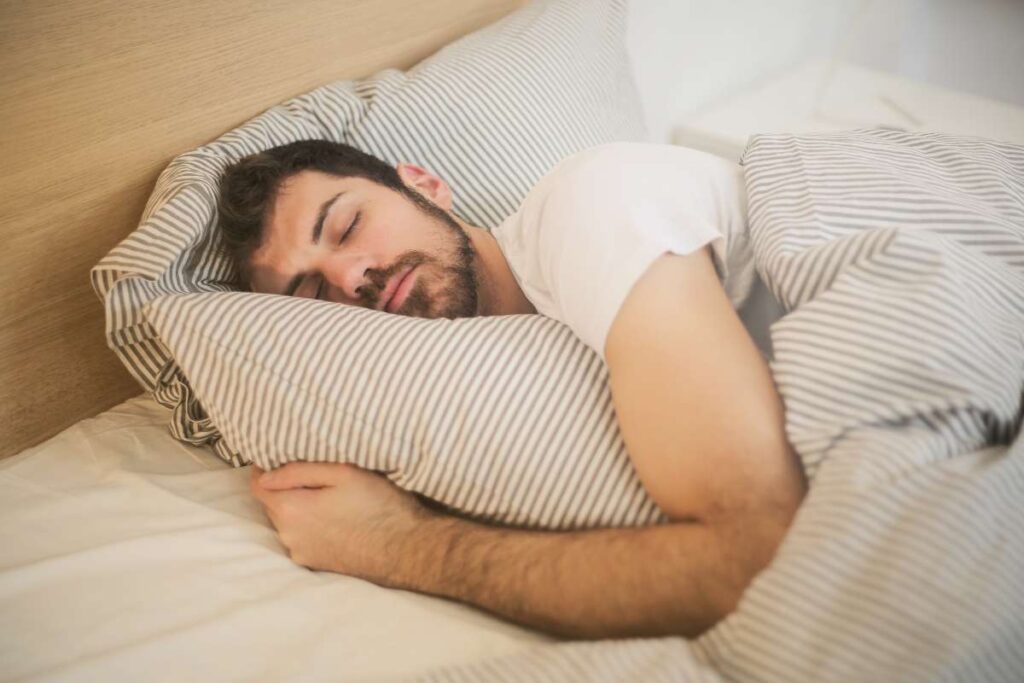
Sleep can have an effect on appetite, making you eat more.
Research shows that sleeping less than seven hours a day might increase appetite, which leads to more snacking and including foods higher in calories.
No wonder why after a bad night’s sleep, you only crave donuts, cookies, pastries, and fast food.
Also, high-stress levels can increase cortisol (stress hormone), which can also have an effect on your appetite.
The body senses there is trouble. It doesn’t understand it might be stress due to work or any other reason. As a result, it releases cortisol and adrenaline to start producing more sugar to have enough energy for any sudden escape.
Once stress is lowered, you might get a sugar spike. The immediate energy the body turns to are simple carbs (sugars, pastries, cookies, and other refined grains).
So, if you want to make sure you eat less, take care of your sleep and stress levels.
Opt for ways to help you handle stress, such as meditation, art therapy, journaling, going for a walk, or having some self-care time.
7. Eat Filling Foods First
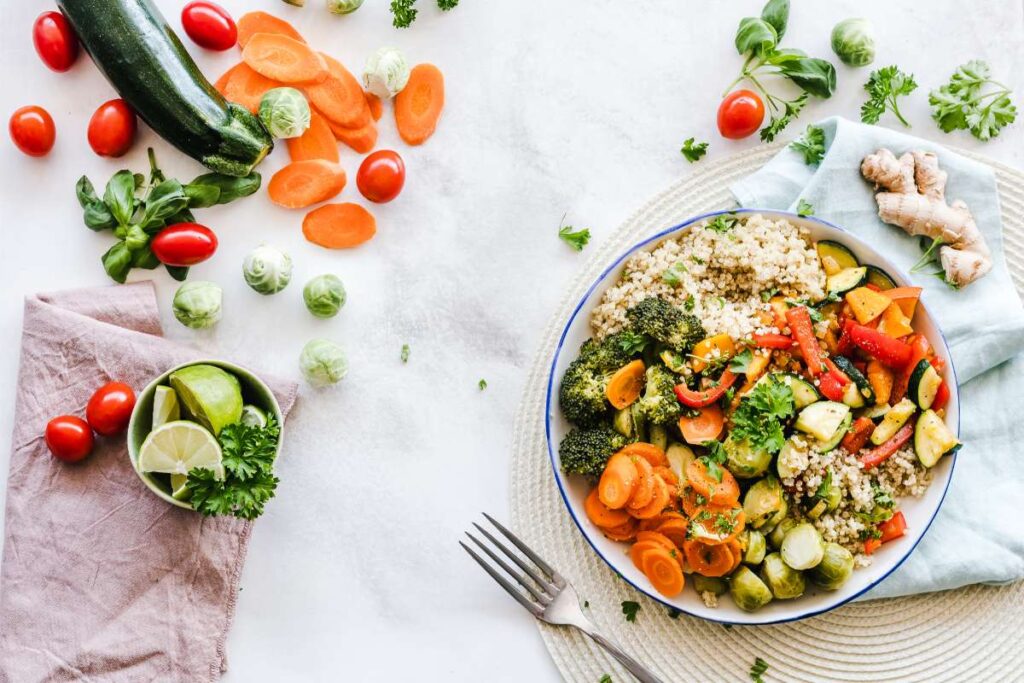
As we previously saw, vegetables and proteins are very filling. One way of making sure you eat fewer calories is to have these filling foods first.
A study showed that those who had a small salad before a meal reduced their calorie intake by 7%, and those who had a larger salad reduced their caloric intake by 12%.
So, next time before you eat, have a salad, vegetable soup, or any entree that is high in non-starchy vegetables and protein.
Whenever having a salad, make sure to ask for the dressing on the side and avoid creamy dressing. These add unwanted calories. Stick to only vegetables and a little bit of olive oil.
If you are going out and most of the entrees are starch-based, one thing I recommend to my clients to help them eat less is to have a protein shake right before going out.
8. Eat Protein with Each Meal

Numerous studies have shown the relationship between a high-protein diet and eating fewer calories.
Evidence suggests that protein can increase fullness levels and slightly increase the metabolism, helping you burn more calories.
Over the years, I’ve come to realize most people have problems reaching their daily protein intake. This leads to an overconsumption of carbs, which are easier to digest, making people overeat and become hungry after a couple of hours.
However, those who focus on protein first tend to feel fuller and eat less.
So, next time you are going to eat, ask yourself: what is the protein in this meal?
And yes, that means for big meals (breakfast, lunch, and dinner), and snacks.
Some great protein options include Greek yogurt, eggs, chicken, fish, seafood, and protein shakes.
9. Weigh Your Foods for Accurate Portion Sizes

If you think you’re eating less but don’t understand why you’re not losing weight, it’s time for a different approach.
When this happens, I always recommend tracking the food for a couple of days to find the problem.
Make sure you’re weighing your food and keep thorough track of it. You can use a calorie counter app to help you create a summary of your meals.
The app can then help you determine if you are eating more calories than you are supposed to and where you can make some changes.
10. Stay Hydrated

Finally, the last tip to help you lose weight is to stay hydrated. In some cases, people mistake their hunger levels for thirst.
A study showed that people who drank a couple of glasses of water before a meal reduced their meal intake by 13%.
So, next time you’re hungry, ask yourself if you have drank enough water throughout the day.
Take a glass of water and occupy your mind. Your hunger levels might probably go down after this.
6 Best Psychological Tricks to Eat Less
The tips mentioned above are some of the best ways to help you eat less.
However, the internal battle of the mind can be challenging. Here are some psychological tricks to eat less.
1. Set Your Intention
To help you eat less, first, understand why you want to achieve weight loss.
Find out what your real purpose is. Vague intentions might work for a short time, but they won’t provide long-lasting results.
Write down exactly what you want to accomplish, how you see yourself in the future, and how you want to feel. The more details you provide, the easier it will be to reduce the amount of food you want.
2. Cut Everything In Smaller Portions
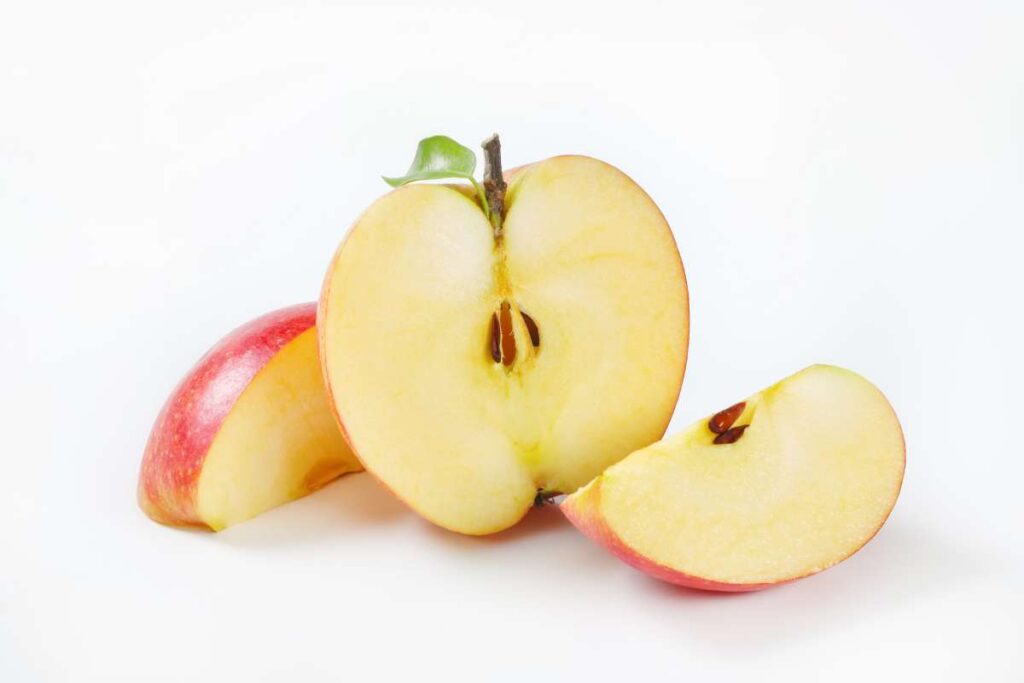
The more food you see on your plate, the more likely you are to feel fuller. Think about it. If you see a whole apple and you put it against a plate with apple slices that fill the plate, which one will your brain think is more filling?
Probably the apple slices.
So, make sure you put everything on a plate and cut it into smaller portions to help you eat less.
3. Avoid Temptation
If you want to prevent yourself from eating those foods you are not supposed to have, make sure you don’t keep those foods at home.
If you share a home and someone else insists on having these foods, ask them to put them in a container and in a place where you won’t see them every day.
You know the saying – out of sight, out of mind.
4. Fight Boredom
One of the most likely reasons most people eat is out of boredom.
Before you start munching on your favorite snack, ask yourself if you are eating because you are hungry or bored.
If you’re bored, look for things to do besides snacking. Play a game, exercise, knit, call a friend. Avoiding boredom eating even a few times a week adds up to make a difference.
5. Find a Community
A support system can help make weight loss or eating less easier to achieve.
Find people on the same page as you, such as a Facebook group or a support group in your area. They can help encourage you on this path and aid in motivation.
6. The Rule of 10%
Finally, I’ve seen how many people strive to make severe changes instead of making them slowly.
In the end, this can lead to people throwing the towel early or getting discouraged because they had a mishap.
Instead, focus on how you can make the dish 10% better next time.
For example, the next time you have soup with a meal, go for broth-based instead of creamy soups.
Smaller steps are more sustainable and make the process more enjoyable.
Can I lose weight without eating less?
You can lose weight without eating less if you burn more calories throughout the day through exercise. However, this can be more difficult to achieve.
In the end, you cannot lose weight without being in a caloric deficit (eating fewer calories than the body needs).
Foods That Help Fill You Up
As we mentioned earlier, there are some foods that can make you less hungry.
Non-starchy vegetables like leafy greens, mushrooms, onions, garlic, eggplant, zucchini, broccoli, and cauliflower are all great low-calorie and highly satiating foods.
Protein is another food group that can fill you up to help you eat less. Include eggs, cheese, Greek yogurt, chicken, and meat.
Make sure you choose lean protein sources to avoid adding more calories due to higher fat content.
Foods To Avoid
As for the foods you want to avoid, these include foods with a low satiating effect and a high calorie content.
Processed foods tend to be lower in fiber, making them easier to digest.
That is why when you eat a couple of slices of white bread you are more likely to look for a snack a couple of hours later. But, when you choose whole grain bread, you feel fuller for longer.
So, those foods you want to avoid include pastries, cookies, processed grains, cakes, sugars, soft drinks, alcoholic beverages, and fast food.
Final Tips
We are almost at the end, but before we finish, there are a couple of final tips that can help you eat less.
Make Food Substitutions
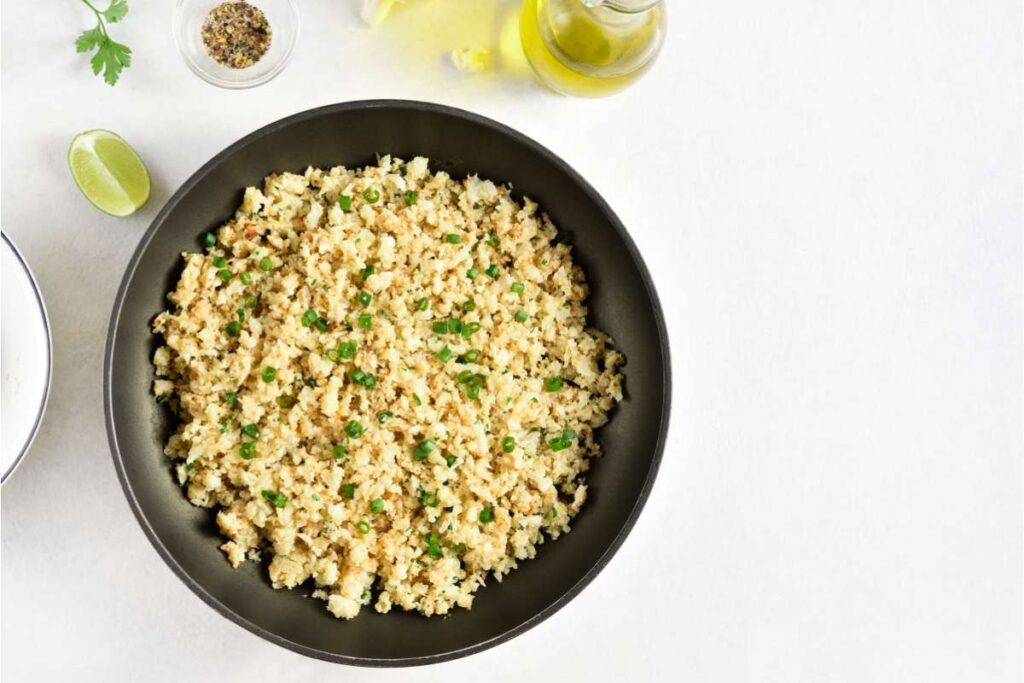
A great way to cut back on the food you are eating is to replace high-carb and high-calorie foods with low-calorie versions.
Here are some food swaps you can try:
- Instead of having white rice, have cauliflower rice or broccoli rice.
- Switch regular pasta for zucchini pasta or hearts of palm pasta.
- Have zucchini chips instead of potato chips.
- Opt for cauliflower crust pizza instead of regular pizza.
If you are not keen on making the switch entirely, make the switch slowly.
For example, have ½ a cup of white rice with ½ cup of cauliflower rice (instead of a full cup of rice).
Exercise
Exercise helps you burn more calories.
Strive to achieve the World Health Organization’s recommendation of doing at least 150 minutes of light to moderate exercise per week.
On top of that, focus on daily movement or non-exercise activity thermogenesis (NEAT).
NEAT is the movement you make through daily activities such as walking, doing chores, or any other activity that helps you move.
Brush Your Teeth
Finally, to help you eat less, brush your teeth immediately after a meal. A clean, minty mouth isn’t as likely to immediately begin snacking again.
Conclusion
Eating less can help you be in a caloric deficit which aids in weight loss.
There are several ways in which you can eat less without relying on following a meal plan, such as eating more protein, choosing to eat vegetables first, or making sure you are drinking plenty of water.
Foods you are going to want to avoid are those with a low satiating effect, such as cookies, pastries, and processed foods.
It’s also key to stay on top of the mental challenges of eating less. Be clear on your goals, ask yourself why you’re eating before you do, and get motivation from others when you need it.
Let me know which of these tips you have tried or which ones you are eager to try, and don’t forget to share this article with anyone who needs help with mindful eating.
Frequently Asked Questions
How to train your stomach to eat less?
Slow changes can help you eat less without feeling hungry.
For example, switch the rice for a lower calorie option such as cauliflower rice. Also, include high-satiating foods like non-starchy vegetables and protein.
How to eat less and not feel hungry?
To avoid feeling hungry while eating less, include high-satiating foods like non-starchy vegetables (leafy green, mushrooms, broccoli, and cauliflower), and protein (eggs, Greek yogurt, and chicken).
How to eat less and have more energy?
To avoid feeling drained when you are eating less, first make sure you are eating enough calories. A registered dietitian can help you determine how many calories you need per day.
Also, include high-satiating carbs like legumes, whole grains, and starchy vegetables. They provide long-term energy.
How to make yourself less hungry?
To feel less hungry, opt for high-satiating foods like protein and vegetables. Also, there are some mind tricks that can help such as eating on smaller plates and making sure you eat slower.

